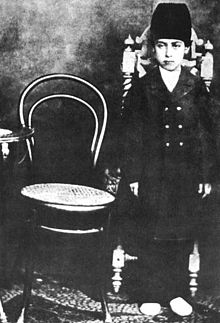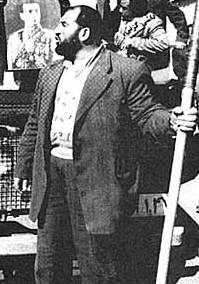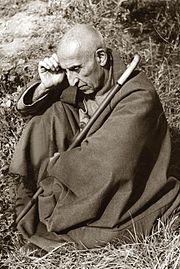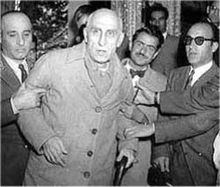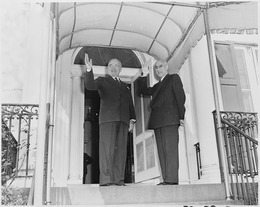www.aljazeerah.info
Opinion Editorials, June 2013
Archives
Mission & Name
Conflict Terminology
Editorials
Gaza Holocaust
Gulf War
Isdood
Islam
News
News Photos
Opinion Editorials
US Foreign Policy (Dr. El-Najjar's Articles)
www.aljazeerah.info
Mass Protests Were Used in the Overthrow of Mohammad Mosaddegh:
An Old Recipe to Precede Military Coups
Al-Jazeerah, CCUN, July 10, 2013
"Soon, massive protests, engineered by Roosevelt's team, took place across the city and elsewhere with tribesmen paid to be at the ready to assist the coup. Anti- and pro-monarchy protesters, both paid by Roosevelt,[56] violently clashed in the streets, looting and burning mosques and newspapers, leaving almost 300 dead."
"Iranian CIA operatives pretending to be socialists and nationalists threatened Muslim leaders with "savage punishment if they opposed Mossadegh," thereby giving the impression that Mossadegh was cracking down on dissent, and stirring anti-Mossadegh sentiments within the religious community." Wikipedia***
Mohammad Mosaddegh
| Mohammad Mosaddegh | |
|---|---|
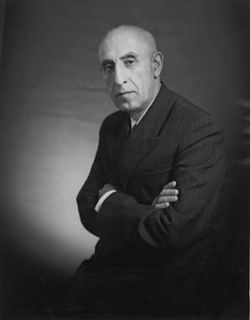 |
|
| 60th and 62nd Prime Minister of Iran | |
|
In office 21 July 1952 – 19 August 1953 |
|
| Monarch | Mohammad Reza Pahlavi |
| Deputy | Ahmad Zirakzadeh |
| Preceded by | Ahmad Qavam |
| Succeeded by | Fazlollah Zahedi |
|
In office 28 April 1951 – 16 July 1952 |
|
| Monarch | Mohammad Reza Pahlavi |
| Deputy | Hossein Fatemi |
| Preceded by | Hossein Ala' |
| Succeeded by | Ahmad Qavam |
| Leader of National Front | |
|
In office 1 January 1949 – 5 March 1967 |
|
| Deputy | Karim Sanjabi |
| Preceded by | Party created |
| Succeeded by | Karim Sanjabi |
| Member of Parliament of Iran | |
|
In office 1 May 1920 – 19 August 1953 |
|
| Constituency | Tehran |
| Personal details | |
| Born | 16
June 1882 Tehran, Iran |
| Died | 5 March 1967
(aged 84) Ahmadabad-e Mosaddeq, Iran |
| Political party | National Front |
| Spouse(s) | Zia od-Saltane (1901–1965) |
| Children | 5 |
| Religion | Islam |
| Signature |
 |
Mohammad Mosaddegh or Mosaddeq
[a] (Persian:
ãõÍóãóÏ ãõÕóÏöÞý; IPA: [mohæmˈmæd(-e)
mosædˈdeɣ] (![]() listen)
[b]; 16 June 1882 – 5 March
1967), was the democratically elected[1][2][3]
Prime Minister of Iran from 1951 to 1953 when his government was
overthrown in a
coup d'état orchestrated by the
British
MI6 and the
American
CIA.[4][5]
listen)
[b]; 16 June 1882 – 5 March
1967), was the democratically elected[1][2][3]
Prime Minister of Iran from 1951 to 1953 when his government was
overthrown in a
coup d'état orchestrated by the
British
MI6 and the
American
CIA.[4][5]
An author, administrator, lawyer, prominent parliamentarian, he became the prime minister of Iran in 1951. His administration introduced a wide range of progressive social and political reforms such as social security, rent control, and land reforms.[6] His government's most notable policy, however, was the nationalization of the Iranian oil industry, which had been under British control since 1913 through the Anglo-Persian Oil Company (APOC / AIOC) (later British Petroleum or BP).[7]
After a rigged referendum dissolving parliament[8], Mosaddegh was removed from power in a coup on 19 August 1953, organised and carried out by the CIA at the request of the British MI6 which chose Iranian General Fazlollah Zahedi to succeed Mosaddegh.[9]
While the coup is commonly referred to as Operation Ajax[10] after its CIA cryptonym, in Iran it is referred to as the 28 Mordad 1332 coup, after its date on the Iranian calendar.[11] Mosaddegh was imprisoned for three years, then put under house arrest until his death.
Contents[hide] |
Early life[edit]
Mossadegh was born to a prominent family in Tehran on 16 June 1882;[12] his father, Mirza Hideyatu'llah Khan, a Bakhtiari tribesman, was a financial administrator in Khorasan province under the Qajar dynasty, and his mother, Shahzadi Malika Taj Khanum, was the granddaughter of the reformist Qajar prince Abbas Mirza, and a great granddaughter of Fat′h-Ali Shah Qajar.[13][14][15] When Mosaddegh's father died in 1892, his uncle was appointed the tax collector of the Khorasan province and was bestowed with the title of Mosaddegh-os-Saltaneh by Nasser al-Din Shah.[16] Mosaddegh himself later bore the same title, by which he was still known to some long after titles were abolished.[17]
In 1901, Mosaddegh married Zahra Khanum (1879–1965), a granddaughter of Nasser al-Din Shah through her mother. The couple had five children, two sons (Ahmad and Ghulam Hussein) and three daughters (Mansura, Zia Ashraf and Khadija).
Education[edit]
Mosaddegh received his bachelor of arts degree[citation needed]] and Masters in (International) Law[citation needed] from the École Libre des Sciences Politiques (Paris) before pursuing a doctorate in law from the University of Neuchâtel in Switzerland.[12] Mosaddegh also taught at the University of Tehran at the start of World War I before beginning his long political career.[18]
Early political career[edit]
Mosaddegh started his political career with the Iranian Constitutional Revolution of 1905/07. At the age of 24, he was elected from Isfahan to the newly inaugurated Persian Parliament, the Majlis of Iran. During this period he also served as deputy leader of the Humanitarian Society, Jameeyate Ensaniat, under Mostowfi ol-Mamalek.[19] In protest of the Anglo-Persian Treaty of 1919, he relocated to Switzerland, from where he returned the following year after being invited by the new Iranian prime minister, Hassan Pirnia (Moshir-ed-Dowleh), to become his minister of justice. While en route to Tehran, he was asked by the people of Shiraz to become the governor of the Fars Province. He was later appointed finance minister, in the government of Ahmad Qavam (Qavam os-Saltaneh) in 1921, and then foreign minister in the government of Moshir-ed-Dowleh in June 1923. He then became governor of the Azerbaijan Province. In 1923, he was re-elected to the Majlis.
In 1925, the supporters of Reza Khan in the Majlis, proposed legislation to dissolve the Qajar dynasty and appoint Reza Khan the new Shah. Mossadegh voted against such a move, arguing that such an act was a subversion of the 1906 Iranian constitution. He gave a speech in the Majlis, praising Reza Khan's achievements as a statesman, while encouraging him to respect the constitution and become the prime minister, not the Shah. On December 12, 1925, the Majlis deposed the young Shah Ahmad Shah Qajar, and declared Reza Shah the new monarch of the Imperial State of Persia, and the first Shah of the Pahlavi dynasty.[20]
In 1941, Reza Shah Pahlavi was forced to abdicate in favor of his son Mohammad Reza Pahlavi by the British. In 1944, Mosaddegh was once again elected to parliament. This time he took the lead of Jebhe Melli (National Front of Iran), an organisation he had founded with nineteen others such as Hossein Fatemi, Ahmad Zirakzadeh, Ali Shayegan and Karim Sanjabi, aiming to establish democracy and end the foreign presence in Iranian politics, especially by nationalising the Anglo-Iranian Oil Company's (AIOC) operations in Iran.
Prime Minister of Iran[edit]
Support for oil nationalization[edit]
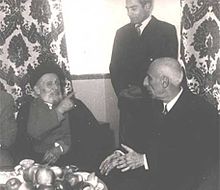
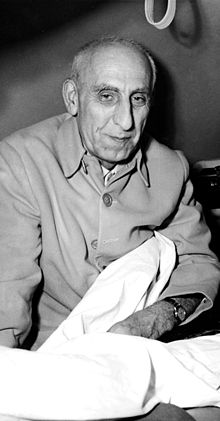
 |
Mossadegh explains about democracy and influence of
Iranians on their movement toward national oil
industry. (in Persian)
|
| Problems playing this file? See media help. | |
Most of Iran's oil reserves were in the Persian Gulf area and had been developed by the British Anglo-Iranian Oil Company (AIOC) for export to Britain. For a number of reasons — a growing consciousness of how little Iran was getting from the AIOC for its oil; refusal of the AIOC to offer of a ‘50–50% profit sharing deal' to Iran as Aramco had to Saudi Arabia; anger over Iran's defeat and occupation by the Allied powers — nationalization of oil was an important and popular issue with "a broad cross-section of the Iranian people".[21]
General Haj-Ali Razmara, the Shah's choice, was approved as prime minister June 1950. On 3 March 1951 he appeared before the Majlis (parliament) in an attempt to persuade the deputies against "full nationalization on the grounds that Iran could not override its international obligations and lacked the capacity to run the oil industry on its own." He was assassinated four days later while praying in the mosque by Khalil Tahmasebi, a member of the militant fundamentalist group Fadayan-e Islam.[22] This order of events, while appearing in many mainstream historical accounts, confronts countervailing evidence. Firstly, "[US]embassy staffers early on speculated that Razmara might either be assassinated or become involved in a power struggle with the Shah".[23] These two concerns appear to converge according to Stephen Kinzer, who notes that:[24][25]
“[e]vidence emerged to suggest that the fatal shot had been fired not by Tahmasibi but by a soldier acting on behalf of the Shah or members of his inner circle, and that Asadollah Alam had knowingly driven him to his fatal rendezvous. Years later a retired Iranian colonel wrote in his memoir that the fatal shot had come from a Colt revolver, available only to soldiers. “An army sergeant, in civilian clothes, was chosen for the deed”, he asserted. “He had been told to shoot and kill Razmara with a Colt, the moment Tahmasibi began to shoot... Those who had examined the wounds in Razmara’s body were in no doubt that he had been killed by a Colt bullet, not by the bullet of a weak gun.”
While this account is corroborated by several other studies,[26] it remains a point of contention among historians. After negotiations for higher oil royalties failed, on 15 March and 20 March 1951, the Iranian Imperial State of Iran: National Consultative Assembly and Senate voted to nationalize the British-owned and operated AIOC, taking control of Iran's oil industry.
Another force for nationalization was the Tudeh or Communist party. In early April 1951 the party organised nationwide strikes and riots in protest against delays in nationalization of the oil industry along with low wages and bad housing in the oil industry. This display of strength, along with public celebration at the assassination of general Razmara made an impact on the deputies of the Majlis.[27]
Election as Prime Minister[edit]
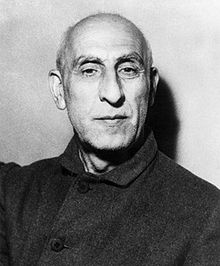
On 28 April 1951, the Majlis (Parliament of Iran) named Mosaddegh as new Prime Minister by a vote of 79–12. Aware of Mosaddegh's rising popularity and political power, the young Shah appointed Mosaddegh to the Premiership.
The new administration introduced a wide range of social reforms: Unemployment compensation was introduced, factory owners were ordered to pay benefits to sick and injured workers, and peasants were freed from forced labor in their landlords' estates. Twenty percent of the money landlords received in rent was placed in a fund to pay for development projects such as public baths, rural housing, and pest control.[28]
On 1 May, Mosaddegh nationalized the AIOC, cancelling its oil concession due to expire in 1993 and expropriating its assets. The next month a committee of five majlis deputies was sent to Khuzistan to enforce the nationalization.[29][30] Mosaddegh explained his nationalization policy in a 21 June 1951 speech:
| “ |
Our long years of negotiations with foreign countries...
have yielded no results thus far. With the oil revenues we
could meet our entire budget and combat poverty, disease,
and backwardness among our people. Another important
consideration is that by the elimination of the power of the
British company, we would also eliminate corruption and
intrigue, by means of which the internal affairs of our
country have been influenced. Once this tutelage has ceased,
Iran will have achieved its economic and political
independence. The Iranian state prefers to take over the production of petroleum itself. The company should do nothing else but return its property to the rightful owners. The nationalization law provide that 25% of the net profits on oil be set aside to meet all the legitimate claims of the company for compensation... It has been asserted abroad that Iran intends to expel the foreign oil experts from the country and then shut down oil installations. Not only is this allegation absurd; it is utter invention...”[31] |
” |
The confrontation between Iran and Britain escalated as Mosaddegh's government refused to allow the British any involvement in Iran's oil industry, and Britain made sure Iran could sell no oil. In July, Mosaddegh broke off negotiations with AIOC after it threatened "to pull out its employees", and told owners of oil tanker ships that "receipts from the Iranian government would not be accepted on the world market." Two months later the AIOC evacuated its technicians and closed down the oil installations. Under nationalized management many refineries lacked the trained technicians that were needed to continue production. The British government announced a de facto blockade, reinforced its naval force in the Persian Gulf and lodged complaints against Iran before the United Nations Security Council.[29]
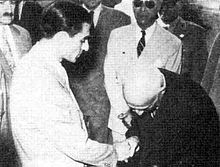
The British government also threatened legal action against purchasers of oil produced in the formerly British-controlled refineries and obtained an agreement with its sister international oil companies not to fill in where the AIOC was boycotting Iran. The entire Iranian oil industry came to a virtual standstill, oil production dropping from 241,400,000 barrels (38,380,000 m3) in 1950 to 10,600,000 barrels (1,690,000 m3) in 1952. This Abadan Crisis reduced Iran's oil income to almost nil, putting a severe strain on the implementation of Mosaddegh's promised domestic reforms. At the same time BP and Aramco doubled their production in Saudi Arabia, Kuwait and Iraq, to make up for lost production in Iran so that no hardship was felt in Britain.
Still enormously popular in late 1951, Mosaddegh called elections. His base of support was in urban areas and not in the provinces.[32] This fact was reflected in the rejection of Mosaddegh's bill for electoral reform (which no longer disqualified illiterates from electoral participation) by the conservative bloc, on the grounds that it would "unjustly discriminate patriots who had been voting for the last forty years".[33]
According to Ervand Abrahamian: "Realizing that the opposition would take the vast majority of the provincial seats, Mosaddegh stopped the voting as soon as 79 deputies – just enough to form a parliamentary quorum — had been elected."[34] An alternative account is offered by Stephen Kinzer. Beginning in the early 1950s under the guidance of C.M. Woodhouse, chief of the British intelligence station in Tehran, Britain's covert operations network had funneled roughly £10,000 per month to the Rashidian brothers (two of Iran's most influential royalists) in the hope of buying off, according to CIA estimates, "the armed forces, the Majlis (Iranian parliament), religious leaders, the press, street gangs, politicians and other influential figures".[35] Thus, in his statement asserting electoral manipulation by "foreign agents", Mosaddegh suspended the elections. His National Front party had made up 30 of the 79 deputies elected. Yet none of those present vetoed the statement, and the elections were postponed indefinitely. The 17th Majlis convened on February 1952.
Tension soon began to escalate in the Majlis. Conservative opponents refused to grant Mosaddegh special powers to deal with the economic crisis caused by the sharp drop in revenue and voiced regional grievances against the capital Tehran, while the National Front waged "a propaganda war against the landed upper class".[32]
Resignation and uprising[edit]
On 16 July 1952, during the royal approval of his new cabinet, Mosaddegh insisted on the constitutional prerogative of the Prime Minister to name a Minister of War and the Chief of Staff, something the Shah had done hitherto. The Shah refused, and Mosaddegh announced his resignation appealing directly to the public for support, pronouncing that "in the present situation, the struggle started by the Iranian people cannot be brought to a victorious conclusion".[36]
Veteran politician Ahmad Qavam (also known as Ghavam os-Saltaneh) was appointed as Iran's new Prime Minister. On the day of his appointment, he announced his intention to resume negotiations with the British to end the oil dispute, a reversal of Mosaddegh's policy. The National Front — along with various Nationalist, Islamist, and socialist parties and groups[37] — including Tudeh — responded by calling for protests, strikes and mass demonstrations in favor of Mosaddegh. Major strikes broke out in all of Iran's major towns, with the Bazaar closing down in Tehran. Over 250 demonstrators in Tehran, Hamadan, Ahvaz, Isfahan, and Kermanshah were killed or suffered serious injuries.[38]
After five days of mass demonstrations on Siyeh-i Tir (the 30th of Tir on the Iranian calendar), military commanders ordered their troops back to barracks, fearful of overstraining the enlisted men's loyalty and left Tehran in the hands of the protesters.[39] Frightened by the unrest, Shah dismissed Qavam and re-appointed Mosaddegh, granting him the full control of the military he had previously demanded.
Reinstatement and emergency powers[edit]
More popular than ever, a greatly strengthened Mosaddegh convinced parliament to grant him emergency powers for six months "to decree any law he felt necessary for obtaining not only financial solvency, but also electoral, judicial, and educational reforms".[40] Mosaddegh appointed Ayatollah Abol-Ghasem Kashani as House Speaker. Kashani's Islamic scholars, as well as the Tudeh Party, proved to be two of Mosaddegh's key political allies, although relations with both were often strained.
With his emergency powers, Mosaddegh tried to strengthen the democratic political institutions by limiting the monarchy's unconstitutional powers,[41] cutting the Shah's personal budget, forbidding him to communicate directly with foreign diplomats, transferring royal lands back to the state and expelling his politically active sister Ashraf Pahlavi.[39]
In January 1953 Mosaddegh successfully pressed Parliament to extend "emergency powers for another 12 months". With these powers, he decreed a land reform law that established village councils and increased the peasants' share of production.[40] This weakened the landed aristocracy, abolishing Iran's centuries-old feudal agriculture sector, replacing it with a system of collective farming and government land ownership. Mosaddegh saw these reforms as a means of checking the power of the Tudeh Party, which had been agitating for general land reform among the peasants.
However, during this time Iranians were "becoming poorer and unhappier by the day" thanks to the British boycott. Mosaddegh's political coalition began to fray, his enemies increased in number.[42]
Partly through the efforts of Iranians working as British agents, several former members of Mosaddegh's coalition turned against him. They included Mozzafar Baghai, head of the worker-based Toilers party; Hussein Makki, who had helped lead the takeover of the Abadan refinery and was at one point considered Mosadegh's heir apparent; and most outspokenly Ayatollah Kashani, who damned Mosaddegh with the "vitriol he had once reserved for the British".[43]
Overthrow of Mosaddegh[edit]
Plot to depose Mosaddegh[edit]
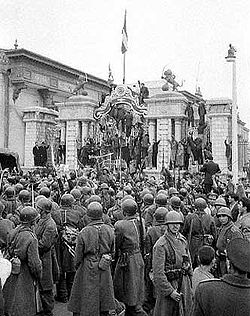
The British government had grown increasingly distressed over Mosaddegh's policies and were especially bitter over the loss of their control of the Iranian oil industry. Repeated attempts to reach a settlement had failed, and, in October 1952, Mosaddegh declared Britain an enemy and cut all diplomatic relations.[44]
Engulfed in a whole range of problems following World War II, Britain was unable to resolve the issue single-handedly and looked towards the United States to settle the issue. Initially, America had opposed British policies. After U.S. mediation had failed several times to bring about a settlement, American Secretary of State Dean Acheson concluded that the British were "destructive, and determined on a rule-or-ruin policy in Iran."[45]
The American position shifted in late 1952, when Dwight D. Eisenhower had been elected U.S. President. In November and December, British intelligence officials suggested to American intelligence that the prime minister should be ousted. British prime minister Winston Churchill suggested to the incoming Eisenhower administration that Mossadegh, despite his open disgust with socialism, was, or would become, dependent on the pro-Soviet Tudeh Party,[46] resulting in Iran "increasingly turning towards communism" and towards the Soviet sphere at a time of high Cold War fears.[47][48][49][50] After the Eisenhower administration had entered office in early 1953, the United States and the United Kingdom agreed to work together toward Mosaddegh's removal and began to publicly denounce Mosaddegh's policies for Iran as harmful to the country. In the meantime, the already precarious alliance between Mosaddegh and Kashani was severed in January 1953, when Kashani opposed Mosaddegh's demand that his increased powers be extended for a period of one year.
Operation Ajax[edit]
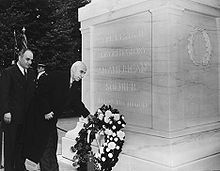
In March 1953, Secretary of State John Foster Dulles directed the Central Intelligence Agency (CIA), which was headed by his younger brother Allen Dulles, to draft plans to overthrow Mosaddegh.[51] On 4 April 1953, Allen Dulles approved US$1 million to be used "in any way that would bring about the fall of Mosaddegh". Soon the CIA's Tehran station started to launch a propaganda campaign against Mosaddegh. Finally, according to The New York Times, in early June, American and British intelligence officials met again, this time in Beirut, and put the finishing touches on the strategy. Soon afterward, according to his later published accounts, the chief of the CIA's Near East and Africa division, Kermit Roosevelt, Jr. the grandson of U.S. President Theodore Roosevelt, arrived in Tehran to direct it.[52] In 2000, The New York Times made partial publication of a leaked CIA document titled Clandestine Service History – Overthrow of Premier Mosaddegh of Iran – November 1952-August 1953. This document describes the point-by-point planning of the coup by agent Donald Wilber, and execution conducted by the American and British governments. The New York Times published this critical document with the names omitted. The New York Times also limited its publication to scanned image (bitmap) format, rather than machine-readable text. This document was eventually published properly – in text form, and fully unexpurgated. The word blowback in the context of covert operations appeared for the very first time in this document.[citation needed]
The plot, known as Operation Ajax, centered on convincing Iran's monarch to issue a decree to dismiss Mosaddegh from office, as he had attempted some months earlier. But the Shah was terrified to attempt such a dangerously unpopular and legally questionable move, and it would take much persuasion and many U.S. funded meetings, which included bribing his sister Ashraf with a mink coat and money, to successfully change his mind.[53]
Mosaddegh became aware of the plots against him and grew increasingly wary of conspirators acting within his government.[54] According to Dr. Donald N. Wilber, who was involved in the plot to remove Mossadegh from power, in early August, Iranian CIA operatives pretending to be socialists and nationalists threatened Muslim leaders with "savage punishment if they opposed Mossadegh," thereby giving the impression that Mossadegh was cracking down on dissent, and stirring anti-Mossadegh sentiments within the religious community. A referendum to dissolve parliament and give the prime minister power to make law was submitted to voters, and it passed with 99 percent approval, 2,043,300 votes to 1300 votes against.[55] According to Mark J. Gasiorowski, "There were separate polling stations for yes and no votes, producing sharp criticism of Mosaddeq" and that the "controversial referendum...gave the CIA's precoup propaganda campaign an easy target". On or around Aug. 16, Parliament was suspended indefinitely, and Mosaddeq's emergency powers were extended.
Overthrow[edit]
In August 1953, the Shah finally agreed to Mossadegh's overthrow, after Roosevelt said that the U.S. would proceed with or without him[56] and formally dismissed the prime minister in a written decree, an act that had been made part of the constitution during the Constitution Assembly of 1949, convened under martial law, at which time the power of the monarchy was increased in various ways by the Shah himself.[57] As a precautionary measure, he flew to Baghdad and from there hid safely in Rome. He actually signed two decrees, one dismissing Mosaddegh and the other nominating the CIA's choice, General Fazlollah Zahedi, as Prime Minister. These decrees, called Farmāns, were specifically written as dictated by Donald Wilber, the CIA architect of the plan, and were designed as a major part of Wilber's strategy to give the impression of legitimacy to the secret coup, as can be read in the declassified plan itself, which bears his name. Wilber was later given a letter of commendation by Alan Dulles, CIA head, for his work. It too is now declassified, and appears in Wilber's autobiography.[citation needed]
Soon, massive protests, engineered by Roosevelt's team, took place across the city and elsewhere with tribesmen paid to be at the ready to assist the coup. Anti- and pro-monarchy protesters, both paid by Roosevelt,
[56] violently clashed in the streets, looting and burning mosques and newspapers, leaving almost 300 dead. The pro-monarchy leadership, chosen, hidden and finally unleashed at the right moment by the CIA team, led by retired army General and former Minister of Interior in Mosaddegh's cabinet, Fazlollah Zahedi joined with underground figures such as the Rashidian brothers and local strongman Shaban Jafari,[58] to gain the upper hand on 19 August 1953 (28 Mordad). The military joined on cue: pro-Shah tank regiments stormed the capital and bombarded the prime minister's official residence, on Roosevelt's cue, according to his book. Mosaddegh managed to flee from the mob that set in to ransack his house, and, the following day, surrendered to General Zahedi, who was meanwhile set up by the CIA with makeshift headquarters at the Officers' Club. Mosaddegh was arrested at the Officers' Club and transferred to a military jail shortly after.[59] On 22 August, the Shah returned from Rome.Zahedi's new government soon reached an agreement with foreign oil companies to form a consortium and "restore the flow of Iranian oil to world markets in substantial quantities", giving the U.S. and Great Britain the lion's share of Iran's oil. In return, the U.S. massively funded the Shah's resulting government, including his army and secret police force, SAVAK, until the Shah's overthrow in 1979.[60]
As soon as the coup succeeded, many of Mosaddegh's former associates and supporters were tried, imprisoned, and tortured. Some were sentenced to death and executed.[61] The minister of Foreign Affairs and the closest associate of Mosaddegh, Hossein Fatemi, was executed by order of the Shah's military court. The order was carried out by firing squad on October 29, 1953.[62]
Trial and final years[edit]
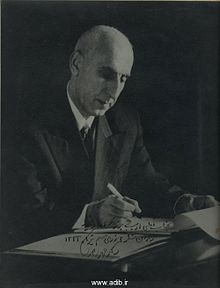
Shortly after the Shah's return, Mosaddegh was tried for treason by the Shah's military court. On 19 December 1953, defending himself against the treason charge, he said:
| “ | Yes, my sin — my greater sin and even my greatest sin is that I nationalized Iran's oil industry and discarded the system of political and economic exploitation by the world's greatest empire. This at the cost to myself, my family; and at the risk of losing my life, my honor and my property. With God's blessing and the will of the people, I fought this savage and dreadful system of international espionage and colonialism .... I am well aware that my fate must serve as an example in the future throughout the Middle East in breaking the chains of slavery and servitude to colonial interests.[63] | ” |
On 21 December 1953, he was sentenced to death but his sentence was later commuted to three years' solitary confinement in a military prison. He was kept under house arrest at his Ahmadabad residence, until his death, on 5 March 1967.[64][65][66][67]
Legacy[edit]
Iran[edit]
The secret U.S. overthrow of Mosaddegh served as a rallying point in anti-US protests during the 1979 Iranian Revolution and to this day he is said to be one of the most popular figures in Iranian history.[68] Despite this, he is generally ignored by the government of the Islamic Republic because of his secularism and western manners.[69]
The withdrawal of support for Mosaddegh by the powerful Shia clergy has been regarded as having been motivated by their fear of the chaos of a communist takeover.[70] Some argue that while many elements of Mosaddegh's coalition abandoned him it was the loss of support from Ayatollah Abol-Ghasem Kashani and other clergy that was fatal to his cause, reflective of the dominance of the Ulema in Iranian society and a portent of the Islamic Revolution to come. The loss of the political clerics effectively cut Mosaddegh's connections with the lower middle classes and the Iranian masses which are crucial to any popular movement in Iran.[71]
U.S. and other countries[edit]
The US role in Mosaddegh's overthrow was not formally acknowledged for many years, although the Eisenhower administration vehemently opposed Mossadegh's policies. President Eisenhower wrote angrily about Mosaddegh in his memoirs, describing him as impractical and naive. However, Eisenhower did not admit any involvement with the coup.
Eventually the CIA's involvement with the coup was exposed. This caused controversy within the organization and the CIA congressional hearings of the 1970s. CIA supporters maintained that the coup was strategically necessary, and praised the efficiency of the agents responsible. Critics say the scheme was paranoid, colonial, illegal, and immoral—and truly caused the "blowback" suggested in the pre-coup analysis. The extent of this "blowback," over time, was not completely clear to the CIA, as they had an inaccurate picture of the stability of the Shah's regime. The Iranian Revolution of 1979 caught the CIA and the US very much off guard (as CIA reporting a mere month earlier predicted no imminent insurrectionary turbulence whatsoever for the Shah's regime), and resulted in the overthrow of the Shah (himself a non-democratic ruler) by a fundamentalist faction opposed to the US, headed by Ayatollah Khomeini. In retrospect, not only did the CIA and the US underestimate the extent of popular discontent for the Shah, but much of that discontent historically stemmed from the removal of Mosaddegh and the subsequent clientelism of the Shah. The US-backed coup, in effect, had ended Iran's last fully democratic government, and there would be no return of democracy even after the Shah's removal.
In March 2000, Secretary of State Madeleine Albright stated her regret that Mosaddegh was ousted: "The Eisenhower administration believed its actions were justified for strategic reasons. But the coup was clearly a setback for Iran's political development and it is easy to see now why many Iranians continue to resent this intervention by America." In the same year, The New York Times published a detailed report about the coup based on declassified CIA documents.[9]
Due to his worldwide popularity, defiance of Britain, and fight for democracy, Mosaddegh was named as Time magazine's 1951 Man of the Year. Others considered for that year's title included Dean Acheson, General (and future President) Dwight D. Eisenhower and General Douglas MacArthur.[72]
In early 2004, the Egyptian government changed a street name in Cairo from Pahlavi to Mosaddegh to improve relations with Iran.
Mosaddegh in the media[edit]
The figure of Mohammad Mosaddegh was an important element in the 2003 French TV production Soraya,[73] which deals with the life of the Shah's second wife and former Queen of Iran, Princess Soraya Esfandiary Bakhtiari. Mosaddegh's role was played by the French actor Claude Brasseur.
A short 24 minute film named Mossadegh, directed by Roozbeh Dadvand, was released in 2011. The role of Mosaddegh was played by Iranian-American actor, David Diaan.[74]
An independent video game called The Cat and the Coup was released in 2011. It features the player playing as Mosaddegh's cat reversing Mossaddegh's life to the beginning.
During the Republican Primary debates with the 2012 Presidential candidates, Texas congressman Ron Paul stated that the reason why Iran has resorted to becoming a theocratic dictatorship was because of the CIA backed Coup in 1953 overthrowing Mohammad Mosaddegh which led up to the 1979 Iranian Revolution causing many problems over the last 30 years.[75]
The life of Mohammad Mosadegh, and the 1953 coup was the subject of the 2012 Link TV documentary American Coup.
Notes[edit]
References[edit]
- ^ Andrew Burke, Mark Elliott & Kamin Mohammadi, Iran (Lonely Planet, 2004; ISBN 1740594258), p. 34.
- ^ Cold War and the 1950s (Social Studies School Service, 2007: ISBN 1560042931), p. 108.
- ^ Loretta Capeheart and Dragan Milovanovic, Social Justice: Theories, Issues, and Movements (Rutgers University Press, 2007; ISBN 0813540380), p. 186.
- ^ James Risen (2000). "SECRETS OF HISTORY The C.I.A. in Iran THE COUP First Few Days Look Disastrous". nytimes.com.
- ^ Stephen Kinzer, John Wiley; David S. Robarge (April 12, 2007). "All the Shah's Men: An American Coup and the Roots of Middle East Terror". Central Intelligence Agency.
- ^ Christopher de Bellaigue (22 July 2012). "Patriot of Persia: Muhammad Mossadegh and a Tragic Anglo-American Coup". Washington Post. Retrieved 23 July 2012.
- ^ Daniel Yergin, The Prize: The Epic Quest for Oil, Money and Power (ISBN 9781439110126).
- ^ Richelson, Jeffery (1997). A Century of Spies: Intelligence in the Twentieth Century. Oxford University Press. p. 249. ISBN 0-520-25328-0.
- ^ a b James Risen (16 April 2000). "Secrets of History: The C.I.A. in Iran". The New York Times. Retrieved 3 November 2006.
- ^ Dan De Luce (20 September 2003). "The Spectre of Operation Ajax". London: Guardian Unlimited. Retrieved 3 November 2006.
- ^ Mark Gasiorowski; Malcolm Byrne (22 June 2004). "Mohammad Mosaddegh and the 1953 Coup in Iran". National Security Archive. Retrieved 3 November 2006.
- ^ a b "Biography". Web Site for Dr. M. Mosaddegh. Retrieved 9 November 2012.
- ^ Mohammad Mossadegh: Political biography By Farhad Dība, p4
- ^ The Cold War, 1945-1991: Leaders and other important figures in the Soviet Union, Eastern Europe, China, and the Third World by Benjamin Frankel
- ^ Afkhami, Gholam Reza (2009). The life and times of the Shah. University of California Press. p. 110. ISBN 0-520-25328-0.
- ^ Key figures, London: The Telegraph, 4 June 2003, retrieved 7 November 2007
- ^ Peter Avery, Modern Iran (Praeger, 1965), p. 273: "Older people still speak of Dr. Musaddiq as Musaddiqu's-Saltanah."
- ^ IFVC, The Political Life and Legacy of Mosaddegh, Bahman Maghsoudlou, Iranian Film Directors, New Productions
- ^ Baktiar, Salar (24 November 2004). "The life of Mirza Hassan Khan, Mostofi Al Mamalek". Retrieved 31 July 2011.
- ^ Mohammad Mossadegh: political biography By Farhad Dība, p. 41
- ^ Saikal, Amin The Rise and Fall of the Shah, Princeton University Press, 1980, p. 38.
- ^ Saikal, 1980, p. 38–9.
- ^ Linda Wills Qaimmaqami (1995), "The Catalyst of Nationalization: Max Thornburg and the Failure of Private Sector Developmentalism in Iran, 1947 - 1951", Diplomatic History, vol. 19, no. 1, pp. 1-31.
- ^ Stephen Kinzer (2003), All the Shah's Men, Wiley, ISBN 0-471-26517-9, pp. 78-9.
- ^ HarperCollins, 2003, ISBN 0-06-055973-X, page 88
- ^ See, for example, Homa Katouzian (1981), Political Economy of Modern Iran, p. 160; Mostafa Elm (1992), Oil, Power, and Principle, p. 80.
- ^ Abrahamian, Ervand. Iran Between Two Revolutions, Princeton University Press, 1982, p. 266.
- ^ http://www.atimes.com/atimes/Middle_East/FI15Ak03.html.
- ^ a b Abrahamian (1982) p. 268.
- ^ Alan W. Ford, The Anglo-Iranian Oil Dispute of 1951-1952. University of california Press, Berkeley 1954, p. 268.
- ^ M. Fateh, Panjah Sal-e Naft-e Iran, p. 525.
- ^ a b Abrahamian (1982), p. 268–70.
- ^ Abrahamian (1982), pp. 268–9.
- ^ Abrahamian (1982), p. 269.
- ^ Kinzer, All the Shah's Men, (2003) pp. 150-1.
- ^ Abrahamian (1982), pp. 270–1.
- ^ Mosaddegh: The Years of Struggle and Opposition by Col. Gholamreza Nejati, p. 761.
- ^ Abrahamian (1982), p. 271.
- ^ a b Abrahamian (1982), p. 272.
- ^ a b Abrahamian (1982), p. 273.
- ^ Zabih, Sepehr. The Mosaddegh Era: Roots of the Iranian Revolution, p. 65.
- ^ Kinzer, All the Shah's Men (2003) p.135-6
- ^ Kinzer, All the Shah's Men (2003) p.159
- ^ No traction for proposal to name street after Mosaddegh. Tehran Times. 10 April 2009
- ^ Saikal, Amin, The Rise and Fall of the Shah, Princeton University Press, 1980, p. 42.
- ^ Review of All the Shah's Men by Jonathan Schanzer
- ^ Mark J. Gasiorowski and Malcolm Byrne Mohammad Mosaddegh and the 1953 Coup in Iran, Syracuse University Press, May 2004. ISBN 0-8156-3018-2, p. 125.
- ^ James S. Lay, Jr. (20 November 1952), United States policy regarding the current situation in Iran (pdf), George Washington University, retrieved 7 November 2007 Statement of policy proposed by the National Security Council
- ^ Walter B. Smith, Undersecretary (20 March 1953), First Progress Report on Paragraph 5-1 of NSC 136/1, "U.S. Policy Regarding the Current Situation in Iran" (pdf), George Washington University, retrieved 7 November 2007
- ^ Measures which the United States Government Might Take in Support of a Successor Government to Mosaddegh (pdf), George Washington University, March 1953, retrieved 7 November 2007
- ^ Malcolm Byrne, ed. (2 November 2000), The Secret CIA History of the Iran Coup, 1953, George Washington University, quoting National security Archive Electronic Briefing Book No. 28, retrieved 7 November 2007
- ^ Halberstam, David (1993). The Fifties. New York: Ballentine Books. pp. 366–367. ISBN 0-449-90933-6.
- ^ Kinzer, Stephen (2003). All The Shah's Men. New Jersey: John Wiley &Sons. p. 7. ISBN 0471265179.
- ^ Trying to Persuade a Reluctant Shah, New York Times 7 Dec. 2009.
- ^ Abrahamian, Iran between 2 Revolutions, 1982, (p.274)
- ^ a b Kermit Roosevelt Jr. Countercoup: The Struggle for the Control of Iran (McGraw-Hill, 1979) ISBN 0-07-053590-6.
- ^ Farrokh, Kaveh (2011). Iran at War: 1500–1988. Osprey Publishing. p. 449. ISBN 1780962215.
- ^ Pahlavani: Misinformation, Misconceptions and Misrepresentations
- ^ C.I.A. and Moscow Are Both Surprised, New York Times Dec. 7, 2009.
- ^ Associated Press (6 August 1954), Statements on Iran Oil Accord, The New York Times, retrieved 7 November 2007
- ^ The Modern Middle East:A Political History Since the First World War, University of California Press, 2011-01-03, By Mehran Kamrava, page 148
- ^ Persian Oil: A Study in Power Politics by L.P. Elwell-Sutton. 1955. Lawrence and Wishart Ltd. London. p. 315.
- ^ The Mossadegh project
- ^ Abrahamian, Ervand, Iran Between Two Revolutions by Ervand Abrahamian, (Princeton University Press, 1982), p.280
- ^ Mossadegh – A Medical Biography by Ebrahim Norouzi
- ^ Persian Oil: A Study in Power Politics by L.P. Elwell-Sutton. 1955. Lawrence and Wishart Ltd. London
- ^ Eccentric Nationalist Begets Strange History, New York Times 7 December 2009.
- ^ Noreena Hertz, The Silent Takeover: Global Capitalism and the Death of Democracy, HarperCollins, 2003, ISBN 0-06-055973-X, Page 88
- ^ Abrahamian, Khomeinism (c. 1993).
- ^ Nasr, Vali, The Shia Revival, Norton (2006), p. 124.
- ^ Mackay, Sandra, The Iranians, Plume (1997), p. 203, 4.
- ^ "Mohammad Mosaddegh, Man of the Year". Time magazine. 7 January 1951. Retrieved 19 November 2006.
- ^ Soraya (2003) (TV), Internet Movie Database, retrieved 7 November 2007
- ^ Mossadegh the movie
-
^
http://www.youtube.com/watch?v=PVZTSqI18cc&list=FLhXmElErzCqZcjPIof7TznQ&index=9&feature=plpp_video
Missing or empty
|title=(help)
Further reading[edit]
- (fr) Yves Bomati et Houchang Nahavandi : Mohammad Réza Pahlavi, le dernier shah - 1919-1980 . Editions Perrin, 2013. ((ISBN 2262035873)) ((EAN 978-2262035877))
- Abrahamian, Ervand, Khomeinism: essays on the Islamic Republic. Berkeley: University of California Press, c 1993. 0-520-08173-0
- Abrahamian, Ervand, Iran Between Two Revolutions, By Ervand Abrahamian, Princeton University Press, 1982
- Amir Taheri, The Persian Night: Iran under the Khomeinist Revolution. Encounter Books, 2009, ISBN 978-1-59403-240-0
- Farhad Diba, Dr. Mohammad Mossadegh; A Political Biography. London: Croom Helm, 1986, ISBN 0-7099-4517-5
- Mostafa Elm, Oil, Power, and Principle: Iran's Oil Nationalization and Its Aftermath. Syracuse: Syracuse University Press, 1994, ISBN 0-8156-2642-8
- Mark Gasiorowski, U.S. Foreign Policy and the Shah: Building a Client State in Iran, Cornell University Press, 1991, ISBN 0-8014-2412-7
- Mary Ann Heiss, Empire and Nationhood: The United States, Great Britain, and Iranian Oil, 1950–1954, Columbia University Press,1997, ISBN 0-231-10819-2
- Sattareh Farman Farmaian & Dona Munker, Daughter of Persia: A Woman's Journey from Her Father's Harem through the Islamic Revolution. New York: Three Rivers Press, 2006. ISBN 0-307-33974-2
- Stephen Kinzer, All The Shah's Men: An American Coup and the Roots of Middle East Terror, John Wiley & Sons, 2003, ISBN 0-471-26517-9
- Stephen Kinzer, Overthrow: America's Century of Regime Change from Hawaii to Iraq, Times Books, 2006, ISBN 0-8050-7861-4
- Nikki R. Keddie, Modern Iran: Roots and Results of Revolution, Yale University Press, 2003, ISBN 0-300-09856-1
- Homa Katouzian, Musaddiq and the Struggle for Power in Iran, I B Tauris & Co, 1991, ISBN 1-85043-210-4
- Mohammad Mosaddeq and the 1953 Coup in Iran, edited by Mark J. Gasiorowski and Malcolm Byrne. Translated into Persian as Mosaddegh va Coup de Etat by Ali Morshedizad, Ghasidehsara Pub. Co.
- Mark J. Gasiorowski, The 1953 Coup D'État in Iran, International Journal of Middle East Studies, Vol. 19, No. 3, p. 261–86 (1987). JSTOR
- Tom Gabbay, "The Tehran Conviction" William Morrow, (2009), ISBN 978-0-06-118860-2
- Mehdi Shamshiri: Zendegi Nameh Mohammad Mossadegh. (farsi) 2 ed. lulu.com. ISBN 978-0-578-08305-6.
- Christopher de Bellaigue, "Patriot of Persia". ISBN 978-1-84792-108-6.
Source: https://en.wikipedia.org/wiki/Mohammad_Mosaddegh
|
|
|
|
||
|
||||||
